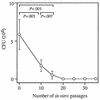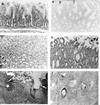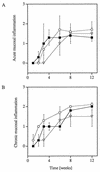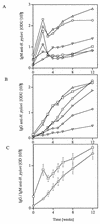Experimental infection of Mongolian gerbils with wild-type and mutant Helicobacter pylori strains
- PMID: 9746590
- PMCID: PMC108601
- DOI: 10.1128/IAI.66.10.4856-4866.1998
Experimental infection of Mongolian gerbils with wild-type and mutant Helicobacter pylori strains
Abstract
Experimental Helicobacter pylori infection was studied in Mongolian gerbils with fresh human isolates that carry or do not carry cagA (cagA-positive or cagA-negative, respectively), multiply passaged laboratory strains, wild-type strain G1.1, or isogenic ureA, cagA, or vacA mutants of G1.1. Animals were sacrificed 1 to 32 weeks after challenge, the stomach was removed from each animal for quantitative culture, urease test, and histologic testing, and blood was collected for antibody determinations. No colonization occurred after >/=20 in vitro passages of wild-type strain G1.1 or with the ureA mutant of G1.1. In contrast, infection occurred in animals challenged with wild-type G1.1 (99 of 101 animals) or the cagA (25 of 25) or vacA (25 of 29) mutant of G1.1. Infection with G1.1 persisted for at least 8 months. All 15 animals challenged with any of three fresh human cagA-positive isolates became infected, in contrast to only 6 (23%) of 26 animals challenged with one of four fresh human cagA-negative isolates (P < 0.001). Similar to infection in humans, H. pylori colonization of gerbils induced gastric inflammation and a systemic antibody response to H. pylori antigens. These data confirm the utility of gerbils as an animal model of H. pylori infection and indicate the importance of bacterial strain characteristics for successful infection.
Figures








Similar articles
-
Infection with CagA-positive Helicobacter pylori strain containing three EPIYA C phosphorylation sites is associated with more severe gastric lesions in experimentally infected Mongolian gerbils (Meriones unguiculatus).Eur J Histochem. 2015 Apr 27;59(2):2489. doi: 10.4081/ejh.2015.2489. Eur J Histochem. 2015. PMID: 26150158 Free PMC article.
-
Helicobacter pylori cag-type IV secretion system facilitates corpus colonization to induce precancerous conditions in Mongolian gerbils.Gastroenterology. 2005 May;128(5):1229-42. doi: 10.1053/j.gastro.2005.02.064. Gastroenterology. 2005. PMID: 15887107
-
A unique Helicobacter pylori strain to study gastric cancer development.Microbiol Spectr. 2025 Jan 7;13(1):e0216324. doi: 10.1128/spectrum.02163-24. Epub 2024 Dec 6. Microbiol Spectr. 2025. PMID: 39641575 Free PMC article.
-
Clinical and histological associations of cagA and vacA genotypes in Helicobacter pylori gastritis.J Clin Pathol. 1998 Jan;51(1):55-61. doi: 10.1136/jcp.51.1.55. J Clin Pathol. 1998. PMID: 9577374 Free PMC article.
-
Identification of Helicobacter in gastric biopsies by PCR based on 16S rDNA sequences: a matter of little significance for the prediction of H. pylori-associated gastritis?J Med Microbiol. 1998 Aug;47(8):695-704. doi: 10.1099/00222615-47-8-695. J Med Microbiol. 1998. PMID: 9877190
Cited by
-
Helicobacter pylori infection and high dietary salt independently induce atrophic gastritis and intestinal metaplasia in commercially available outbred Mongolian gerbils.Dig Dis Sci. 2003 Mar;48(3):475-85. doi: 10.1023/a:1022524313355. Dig Dis Sci. 2003. PMID: 12757158
-
A Tale of Two Toxins: Helicobacter Pylori CagA and VacA Modulate Host Pathways that Impact Disease.Front Microbiol. 2010 Nov 23;1:115. doi: 10.3389/fmicb.2010.00115. eCollection 2010. Front Microbiol. 2010. PMID: 21687723 Free PMC article.
-
Who's Winning the War? Molecular Mechanisms of Antibiotic Resistance in Helicobacter pylori.Curr Drug ther. 2008 Sep 1;3(3):190-203. doi: 10.2174/157488508785747899. Curr Drug ther. 2008. PMID: 21765819 Free PMC article.
-
Infection with CagA-positive Helicobacter pylori strain containing three EPIYA C phosphorylation sites is associated with more severe gastric lesions in experimentally infected Mongolian gerbils (Meriones unguiculatus).Eur J Histochem. 2015 Apr 27;59(2):2489. doi: 10.4081/ejh.2015.2489. Eur J Histochem. 2015. PMID: 26150158 Free PMC article.
-
Rapid genetic analysis of Helicobacter pylori gastric mucosal colonization in suckling mice.Proc Natl Acad Sci U S A. 2002 Jun 11;99(12):8354-9. doi: 10.1073/pnas.122244899. Proc Natl Acad Sci U S A. 2002. PMID: 12060779 Free PMC article.
References
Publication types
MeSH terms
Substances
Grants and funding
LinkOut - more resources
Full Text Sources
Medical

